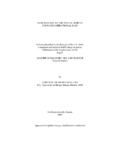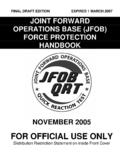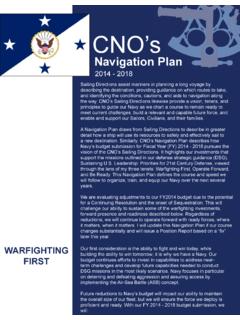Transcription of BY ORDER OF THE AIR FORCE HANDBOOK 31-109 …
1 BY ORDER OF THE SECRETARY OF THE AIR FORCE AIR FORCE HANDBOOK 31-109 1 MAY 2013 Security INTEGRATED defense IN EXPEDITIONARY ENVIRONMENTS COMPLIANCE WITH THIS PUBLICATION IS MANDATORY ACCESSIBILITY: Publications and forms are available on the e-Publishing website at for downloading or ordering. RELEASABILITY: There are no restrictions on the release of this HANDBOOK . OPR: AFSFC/SFOZ Supersedes: AFH31-109, 1 January 1996; , 20 August 2004 Certified by: AF/A7S (Brig Gen Allen J. Jamerson) Pages: 81 This Air FORCE HANDBOOK (AFH) provides Security Forces Commanders and planners with operational level guidance for implementing Integrated defense (ID) throughout the full Range of Military Operations (ROMO) and is not intended to be used as a guide for ID in home station environments.
2 It complements Air FORCE Policy Directive (AFPD) 31-1, Integrated defense , and Air FORCE Instruction (AFI) 31-101, Integrated defense . Ensure that all records created as a result of processes prescribed in this publication are maintained in accordance with Air FORCE Manual (AFMAN) 33-363, Management of Records, and disposed of in accordance with the Air FORCE Records Disposition Schedule (RDS) located in the Air FORCE Records Information Management System (AFRIMS). Refer recommended changes and questions about this publication to the Office of Primary Responsibility (OPR) using the AF Form 847, Recommendation for Change of Publication, and route AF Forms 847 from the field through the appropriate functional chain of command.
3 This publication may be supplemented at any level. The use of the name or mark of any specific manufacturer, commercial product, commodity or service in this publication does not imply endorsement by the Air FORCE . SUMMARY OF CHANGES This AFH has been substantially revised and must be completely reviewed. For example, this document has incorporated concepts and terms used in the most recent version of AFI 31-101. 2 AFH31-109 1 MAY 2013 In addition, Ground defense Postures (GDPs) have been omitted in this version. Finally, new base security assets and concepts are discussed within the contents of this document. Chapter 1 INTRODUCTION TO INTEGRATED defense (ID) 5 A7S Vision.. 5 Introduction to ID Policy and Guidance Structure.
4 5 Key Guidance Structure: .. 5 Background.. 5 ID as a Fundamental Battle Competency.. 6 Threat.. 6 Operational Environments.. 6 Threat Level Examples: .. 6 Figure Threat Spectrum .. 6 ID FORCE Organization.. 7 Chapter 2 INTEGRATED defense COMMAND AND CONTROL 9 General.. 9 The DFC and the S-Staff.. 9 Staff Interaction.. 11 Staff Control Tools.. 11 Figure Range Card.. 13 Squad Sector Sketch.. 14 Figure Squad Sector Sketch.. 14 Flight Sector Sketch.. 14 Figure Flight Sector Sketch .. 15 Fire Control Measures.. 15 Priorities of Work.. 16 ID Communications.. 16 Communication Means.. 16 Chapter 3 PLANNING FOR INTEGRATED defense 19 ID Planning: .. 19 The base Boundary (BB) and BSZ.. 19 Figure base Perimeter, base Boundary and base Security Zone.
5 20 Table ID Desired Effects in the base Boundary and base Security Zone.. 20 AFH31-109 1 MAY 2013 3 The goal of ID is to neutralize security threats throughout the BSZ in ORDER to ensure unhindered USAF, joint and coalition missions.. 21 Military Symbology.. 21 Overlays.. 22 Figure Overlays.. 22 Troop Leading Procedures (TLP).. 22 Figure Troop Leading Procedures.. 23 Figure Example of a Squadron Warning ORDER .. 24 Figure Example of a Flight Warning ORDER .. 25 Figure COA Development.. 27 Figure Example of a Squadron OPORD.. 30 Figure Example of a Flight OPORD.. 33 ID Patrol Organization and Planning.. 38 Organizing for a Patrol.. 38 Planning for a Patrol.. 39 Planning/Organizing for a Convoy.. 40 Chapter 4 CONDUCTING INTEGRATED defense 41 General.
6 41 Anticipate.. 41 Deter.. 41 Detection.. 41 Assess.. 42 Warn.. 42 Defeat.. 42 Delay.. 43 Defend.. 44 Consolidation and Reorganization and Recovery.. 44 Table S-1 and S-4 Reports.. 45 Table S-2 Reports.. 46 Table S-3 Reports.. 47 Types of Operating Environments.. 47 Security Forces Mission Sets.. 49 Military Working Dog Program.. 49 4 AFH31-109 1 MAY 2013 Table Common SF Expeditionary Mission Sets (examples only).. 51 Chapter 5 RESILIENCE AND SURVIVAL 52 Resilience.. 52 Factors Which Cause Unnecessary Hesitation When Reacting to a Threat.. 53 Commander Considerations.. 56 Resiliency and the Individual.. 59 Post-Traumatic Stress Disorder.. 62 Attachment 1 GLOSSARY OF REFERENCES AND SUPPORTING INFORMATION 63 Attachment 2 S-1 BRANCH DUTIES 68 Attachment 3 S-2 BRANCH DUTIES 70 Attachment 4 S-3 BRANCH DUTIES 72 Attachment 5 S-4 BRANCH DUTIES 74 Attachment 6 S-5 BRANCH DUTIES 77 Attachment 7 EXAMPLE OF PRE-COMBAT INSPECTION CHECKLIST 78 Attachment 8 REVERSE TIME SCHEDULE 79 Attachment 9 PROCEDURES TO REQUEST INDIRECT FIRE SUPPORT 80 AFH31-109 1 MAY 2013 5 Chapter 1 INTRODUCTION TO INTEGRATED defense (ID) A7S Vision.
7 Mission-ready, resilient and air-minded Security Forces (SF) organized, trained and equipped to deliver enduring ID against threats to the United States Air FORCE (USAF), Joint and Coalition missions; recognized and respected for our air-centric expertise. Introduction to ID Policy and Guidance Structure. USAF air and space assets are most vulnerable when they are on the ground. Our adversaries mission is to exploit this vulnerability and it is the duty of every Airman to understand and mitigate these risks through the integration of installation defensive capabilities. Per AFPD 31-1, integrated defense is the integration of multidisciplinary active and passive, offensive and defensive capabilities, employed to mitigate potential risks and defeat adversary threats to Air FORCE operations.
8 Integrated defense is planned and executed based upon the estimated threat (or combination of threats), and operating environment; it is approved by the installation commander. This HANDBOOK is a tool for SF leadership to plan for integrated defense operations in expeditionary environments. It is not an instruction but a guide to help leaders. Finally, it should be understood that this document is not all inclusive, and the references mentioned throughout should be utilized in conjunction with this HANDBOOK . Key Guidance Structure: AFPD 31-1 establishes the framework for how the Air FORCE formulates and applies ID and establishes SF as the enterprise leader for ID operations. Although SF is the enterprise lead, ID is an installation commander s program per AFI 31-101.
9 AFI 31-101 describes the concept, planning and execution of ID. Capabilities-based ID is a fundamental battle competency for all Airmen, and requires active participation by all to ensure its success. This publication provides one element of a continually evolving process to provide users with a practical how-to reference, complete with links to additional reference material for all ID Forces. Additionally, reference material can be found on the Security Forces SMARTNet at the following link: Subjects that are specific to SF are addressed as such. Subjects that apply to all Airmen use terms such as ID Forces or Defenders. Security of assets that defend our nation, people and resources is an inherent responsibility of command and requires the effort of every Airman regardless of Air FORCE Specialty Code (AFSC), rank or position.
10 Therefore, tactical terms formerly applied specifically to SF such as Fire Team (FT), Squad, etc, are now applicable to all forces when organized for ID. Background. In 1985, Joint Security Agreement (JSA) 8 committed the Army to provide units under the operational control (OPCON) of the appropriate air component commander to perform air base ground defense outside the base perimeter. In 1992, joint doctrine transferred this responsibility to installation commanders. In 2005, the Chief of Staff of the Army and the Chief of Staff of the Air FORCE formally rescinded JSA 8 saying that "Joint Doctrine and the decisions of Joint FORCE Commanders will be used in place of this document." JP 3-10, Joint Security Operations in Theater, assigns base defense as an installation commander responsibility.















